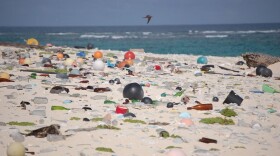Anyone who’s lived under a Midwestern or Great Plains sky knows that we see lightning before we hear its crack and thunder. But on a vacation last August in Alaska, while paddling in the Kenai Fjords National Park, I still found it very strange to watch giant chunks of a tidal glacier plummet into the sea well before I heard the crash.
“That was a big one!” my partner, Al, exclaimed on seeing a chunk the size of an ocean liner break loose. “One thousand one, one thousand two…” Thunder echoed off the surrounding mountains. We couldn’t believe we were two miles away from the glacier – so massive that it seemed to loom almost directly above us. And so beautiful! Tall, pointed spires along the upper reaches resembled the azure glass ramparts of a fairy land castle. Our guide told us we couldn’t get any closer, lest a floating chunk of ice rolled without notice and capsized our kayaks.
Minutes later, waves created by the crash caused our boats to rock. But so far no one had rocked any metaphoric boats. Joe Allen, the seasoned, likable and frank captain who’d ferried us to this spectacular bay at the base of Aialik Glacier, had told us all that he’d seen Aialik retreat several hundred yards over his decades on the water. And we’d commented on the great weather. Last month had been the hottest July ever recorded in Alaska. Yet so far no one on our tour had breathed a word about climate change.
All seven kayakers – our young guide, two young couples, Al, and I – hailed from the lower forty-eight. “See that chunk over on the far left,” the guide called. “Man, I’d like to see that one go!”
I felt a little guilty to be oohing over the calving glaciers. The word “calving” didn’t seem appropriate. To calve is to give birth to new life. This was the glaciers dying, and it was happening worldwide. A sixth of the world’s population depended on disappearing glaciers for their water supply. And melting ice was raising sea levels, already flooding coastal cities, submerging islands, and causing extreme and erratic storms. According to the Worldwatch Institute, a billion people might be affected by the century’s end, and it was no secret that we humans were bringing this upon ourselves, mainly by burning fossil fuels.
Not talking about why the glaciers were shrinking while watching that shrinkage in action seemed cowardly to me. I wouldn’t be able to live with myself if I didn’t say something.
I found my opportunity while chatting with the others onshore after our paddle. I happened to mention that I’d lived in Colorado for several years. “Oh wow, you lived in Colorado?” said one of the young women. She was from Houston, the wife of a chemical engineer. She had been trying to convince her husband to move to Colorado. I extolled the winter climate, which was pretty much always sunny, and the temperatures mild. “The winters have been getting even warmer lately,” I added, “and drier, due to global warming.”
The young woman’s face froze in an expression that rivaled the wall of ice we’d just visited. Oh well, I thought. I tried. Later, the husband and wife from San Francisco began sharing earthquake stories. “They’re probably caused by global warming,” the Houston woman quipped, rolling her eyes at the couple, then glancing furtively my way.
That eye roll has troubled me ever since, because I know that young woman is far from alone in dismissing climate change and its effects as if they were just a silly notions concocted by almost a hundred percent of the world’s climate scientists. Our guide had warned us about ice that could roll and capsize our boats, but human eyes that can roll when confronted with evidence they prefer to ignore endangers us all.







